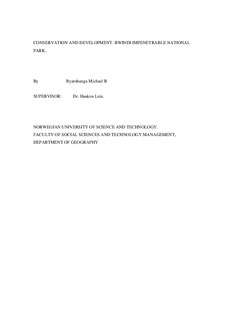| dc.description.abstract | ‘In the past they have been seen as islands of protection in an ocean of destruction. We need to learn to look at them as the building blocks of biodiversity in an ocean of sustainable human development , with their benefits extending far beyond their physical boundaries’ Achim Steiner, IUCN director 2003 in (Adams 2004) referring to the management of national parks. Community conservation as an approach to conservation of wildlife was adopted by many African countries as a means of involving local communities participate in decision making and management of protected areas. This was thought be beneficial for both the development of local communities and general development of rural areas while protecting wildlife after the failure of the exclusionist policy. This thesis explores the concept of community conservation focusing on participation and involvement in conservation and tourism by the local communities in and around Bwindi impenetrable national park in south western Uganda. It assesses whether the principles that guide the application of community conservation to wildlife management have been followed and the forms of participation that the communities are involved in. It further explores the different ways through which communities living in and around the national park have benefited from participating in both tourism and conservation. Lastly the study examines whether there exists conflicts, the causes of those conflicts and how these conflicts affect the relationship between the local communities and the national park authorities.
The theory that informs this study follows alternative development theory and the concept of community conservation. Alternative development focuses on empowering people to take charge of their own development both in decision making and implementation focusing on the role non governmental organizations play. Community conservation emphasises the involvement of communities living around protected areas to participate in both decision making and management of protected areas. Participation in decision making is aimed at empowering people take charge in the management of resources where benefits (economic) are shared amongst the different stakeholders in both conservation and tourism.
A qualitative mode of inquiry is used to collect data that informs this research. Data was collected using formal interviews, informal interviews, observation, questionnaire, life stories and document review. Findings reveal that, communities living in the villages around the national park have been involved in different projects and programmes aimed at conservation and development. It further reveals that there have been benefits accruing from participation delivered through the work of conservation organizations. Despite the benefits, people still feel they deserve more than they are at present getting from the national park. Conflicts between the national park authorities and the local communities exist but these are not at a scale big enough to affect their relationship. Generally this research found out that when community conservation is well implemented with the involvement of local communities, it provides benefits to those communities through tourism, minimises conflict and ends up making the people own the projects targeting wildlife conservation. | nb_NO |
